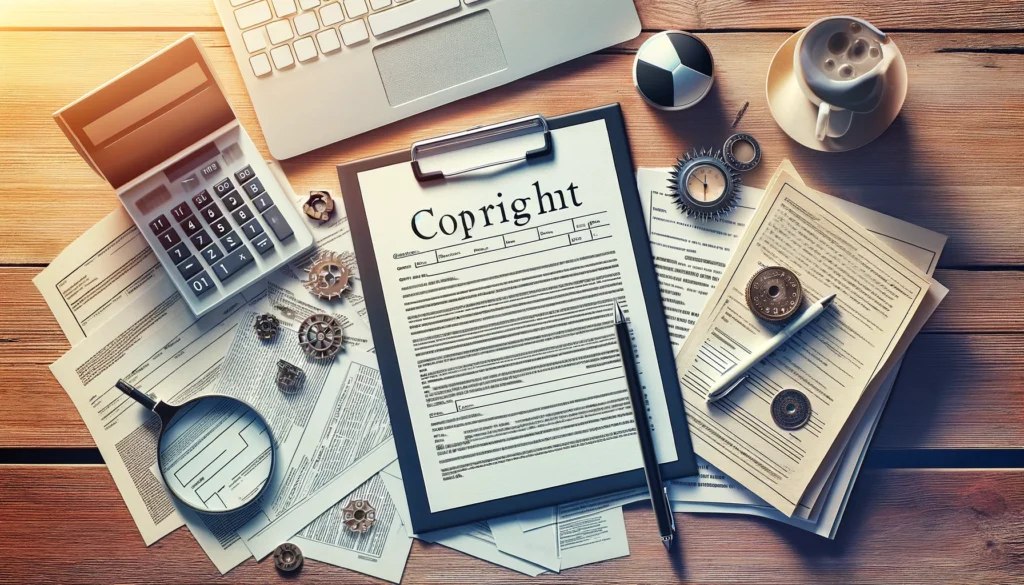Finishing a book is a monumental achievement. It’s like crossing the finish line after a long marathon of creativity, dedication, and hard work. Now, you’re probably looking into how to copyright a book, wanting to ensure that this labor of love is safeguarded against anyone who might try to claim it as their own.
Copyright might sound like a complex legal fortress, but it’s really more of a simple guardrail for your work. It’s the first step in making sure your unique story stays yours, allowing you to share it with the world confidently.
Let’s demystify the process together, turning what seems like a daunting task into an easily navigable path. After all, protecting your book isn’t just about law; it’s about peace of mind for you as an author.
How to Copyright a Book

So, what exactly is copyright? Think of it as the legal recognition that your book is your creation. It’s the law’s way of saying, “Yep, this is yours, and you decide how it’s used.”
The moment you pen down those final words, your work is automatically copyrighted. That means it’s protected, no immediate action required.
But here’s the deal: while copyright exists from the moment your creation is made, registering this copyright with the government adds a layer of protection.
It’s like upgrading from basic security to premium—ensuring that if ever there’s a dispute over your work, you’ve got the evidence to prove it’s yours, backed by the full force of the law.
1. Ensure Your Work is Eligible for Copyright
To set the stage for copyrighting your book, the first step is all about ensuring your work meets the basic criteria for copyright protection. Let’s break this down:
- Originality: Your book should be original. This doesn’t mean it has to reinvent the wheel, but it should come from you and contain your unique expression, ideas, or storytelling. It can’t be a copy of someone else’s work.
- Tangible Form: For your book to be eligible, it needs to be “fixed” in a tangible form. What this means is pretty straightforward: your work must be captured in a medium from which it can be read, seen, or heard, either directly or with the help of a device. Whether it’s typed up on your computer, handwritten in a notebook, or even recorded as an audio file if you’re dictating the story, it needs to exist in a physical or digital form that can be perceived by others.
In essence, if you’ve written a book and it’s something others can read (in print or digitally), then congratulations! You’ve already met the initial requirements for copyright protection. This is the foundational step that paves the way for you to officially register your copyright and fully protect your creative work.
2. Prepare Your Copyright Application

Once you’re sure your book meets the eligibility criteria for copyright, the next step is preparing and submitting your copyright application. Here’s how you can go about it:
- Visit the Official Copyright Office Website: Your first move should be to find the official copyright office website for your country. For those in the United States, that’s the U.S. Copyright Office at copyright.gov. This website is a treasure trove of resources, including detailed guides, FAQs, and the application portal itself.
- Choose Your Filing Method: You have two main options for filing your copyright application: online or via mail. There are a few things to consider when making this choice:
- Online Filing: This is the most popular option because it’s typically faster, more convenient, and less expensive than mailing your application. The website guides you through each step of the process, and you can upload digital copies of your book directly through the portal.
- Mailing Your Application: Some might prefer or find it necessary to mail in their application along with a physical copy of their book. This method is generally slower and more expensive due to the additional costs of printing and postage. However, it might be required or preferred in certain situations, such as when a digital copy of the work isn’t available or doesn’t meet the submission requirements.
Regardless of which method you choose, make sure to follow the instructions provided on the copyright office’s website carefully. This will help ensure your application is processed smoothly and without unnecessary delays.
3. Gather Required Information
Before you dive into the application process, it’s crucial to have all the necessary information on hand. This prep work makes the application process smoother and helps avoid any hiccups along the way. Here’s the key information you’ll need to gather:
- The Title of Your Book: This one might seem obvious, but make sure you have the final, exact title as you want it to appear in the copyright registration. If your book is part of a series, include the series name and the volume number, if applicable.
- The Author’s Name(s) and Any Pseudonyms Used: Copyright law recognizes the person who actually created the work. If you wrote the book, your name goes here. If you’re co-authoring, include the names of all contributors. Did you write under a pseudonym? Include that as well. It’s all about ensuring the credit goes exactly where it’s supposed to.
- The Year of Completion: This is the year you finished writing your book. If you’ve been working on your manuscript over several years, the year of completion is when you finally put down your pen (or closed your laptop) and decided the work was done.
- The Date of Publication: If your book has already been published, you’ll need the exact date it was first made available to the public. This includes self-published works, e-books, or traditionally published books. If your book hasn’t been published yet, you can skip this part.
- Your Contact Information: This includes your current address, phone number, and email address. The copyright office uses this information to contact you about your application, so it’s important that it’s accurate and up-to-date.
Gathering this information before you start the application will save you time and reduce the risk of mistakes. Make sure you double-check everything, especially names and dates, as these are crucial for the copyright record. Once you have all this information ready, you’re set to move on to the next step of the process.
4. Prepare a Copy of Your Work

An essential part of the copyright application process is submitting a copy of your book. This step varies slightly depending on whether your work is published or unpublished.
For unpublished works, the requirement is straightforward: you need to provide a complete copy of your book. This means the entire manuscript as you have finalized it, ready to be reviewed and stored as part of your copyright claim. Make sure this copy is clear and all text is easily readable.
When it comes to published works, the specifics can be a bit different and might depend on when the book was published. Here’s why the date matters: copyright offices sometimes have different requirements for works published at different times. For example, if your book was published after a certain year, you might be able to submit a digital copy. For older publications, a physical copy might be necessary.
It’s a good idea to check the current requirements on the official copyright office website for your country. This ensures you’re providing exactly what’s needed based on the publication status and date of your book. Preparing your book in the correct format and according to the guidelines will help avoid any delays in the registration process.
5. Fill Out the Application Form

After gathering all the necessary information and preparing a copy of your work, the next crucial step is to fill out the copyright application form. This form is your formal request for copyright protection, so accuracy and thoroughness are key.
When you’re ready to fill out the form, either online through the copyright office’s website or on a paper form if you’re mailing your application, here are some tips to ensure a smooth process:
- Review Each Section Carefully: The application form will ask for various details about your book, including everything from the title and authorship to the publication status and date. It will also require your personal information, such as your name, address, and contact details.
- Be Precise with Your Answers: Use the information you gathered earlier to fill in the details accurately. Precision is crucial, especially when it comes to names, dates, and contact information. Any discrepancies or inaccuracies could lead to questions or delays in processing your application.
- Double-Check Your Work: Before submitting the application, review it thoroughly. Check for typos, ensure all fields are correctly filled, and verify that the information matches the details you’ve prepared. This is your chance to catch any mistakes that could complicate your application.
- Follow Submission Instructions: If you’re submitting online, follow the prompts to attach or upload your manuscript as required. For mail submissions, ensure your application form and manuscript are packaged according to the instructions provided by the copyright office.
Taking the time to fill out the application form carefully and accurately is a critical step in securing copyright protection for your book. It’s the formal part of declaring your ownership and your intent to protect your creative work, laying the groundwork for all the benefits and security that copyright offers.
6. Pay the Registration Fee
The next step in the process is paying the registration fee, which is an important part of submitting your copyright application. The cost of registering your copyright can vary based on a few factors, including whether you choose to file your application online or via mail, and whether you’re registering a single work or multiple works at once.
Typically, filing online is less expensive than sending your application by mail. It’s also faster and more efficient, not just in terms of processing time but in terms of costs as well.
If you’re looking to register multiple works under a single application, there might be specific options available that could save you money compared to registering each work individually. This is often an appealing option for authors with several works ready for copyright.
It’s crucial to visit the official website of the copyright office to check the current fees. These fees are subject to change, so confirming the amount you need to pay before you submit your application ensures that you don’t encounter any surprises.
The website will also provide instructions on how to make your payment, whether it’s through an online portal for electronic filings or by including a check or money order for mail submissions.
Ensuring that you pay the correct fee is vital to the smooth processing of your copyright application.
Once you’ve taken care of this step, you’re one step closer to securing the copyright protection for your book, affirming your rights as an author.
7. Submit Your Application and Work

With your application form filled out, your registration fee paid, and a copy of your book ready, you’re now set to submit your copyright application. This step marks the culmination of your preparation and brings you closer to having your book officially copyrighted.
If you’re filing online, which is the route many choose for its convenience and speed, you will upload a digital copy of your book directly through the copyright office’s submission portal.
This process is typically straightforward: after payment, the website will guide you to upload your manuscript file. Make sure the file is in an accepted format and that it’s the complete and final version of your work.
For those who prefer or need to mail their application, you’ll need to prepare a bit more. Along with a printed copy of your application form and the appropriate fee (if you haven’t paid online), you’ll include a printed copy of your book.
Packaging these items securely is important to ensure they arrive in good condition. Use a reliable postal or courier service and consider tracking your package to confirm its arrival at the copyright office.
Regardless of the method you choose, double-check everything before you send it off. Ensure your application is complete, your book copy is correctly prepared, and your payment is settled.
Submitting your application marks a significant step in protecting your creative work, and doing it correctly helps to avoid any delays or issues in the registration process.
Once your application and work are submitted, you’ve done your part for now. The copyright office will review your submission, and while this can take some time, you’ve taken a crucial step in safeguarding your book and your rights as its author.
8. Wait for Confirmation
After you’ve submitted your application and work, the next step is a bit out of your hands—you wait. Once your submission is in, the copyright office will send you a confirmation that they’ve received your application. This confirmation is important because it assures you that your materials have made it to their destination and your application process is officially underway.
The waiting part can test your patience, especially when you’re eager to get your book protected and move forward with your plans for it. Processing times can vary widely depending on the volume of applications the copyright office is handling, any holidays or non-working periods, and the specifics of your application. It’s a good idea to check the copyright office’s website for the current processing time estimates. These estimates can give you a rough idea of how long you might be waiting, though it’s always possible for it to take a bit less or a bit more time.
While waiting, it’s beneficial to keep a record of your submission confirmation and any other correspondence from the copyright office. If you’ve filed online, you might have an account or dashboard where you can check the status of your application. For mail submissions, consider setting reminders to follow up if you haven’t heard back within the expected timeframe.
This period of waiting is a good time to continue working on other projects or start planning how you’ll use or promote your copyrighted work once the registration is complete. Remember, the goal of this process is to ensure your book is protected, and while waiting might feel like a lull in the action, it’s an integral part of securing your rights as an author.
9. Receive Your Copyright Certificate
The final step in the copyright registration process is both rewarding and significant. Once your application has been processed and approved, the copyright office will send you a copyright certificate. This document arrives by mail and represents the culmination of your efforts to protect your book.
The copyright certificate is a tangible acknowledgment of your rights as an author. It serves as prima facie evidence of your copyright ownership, meaning it’s recognized as sufficient proof of your copyright until proven otherwise.
This certificate is crucial, especially if you ever need to enforce your copyright in a legal setting. It details the specifics of your work, the copyright registration number, and the date your copyright was officially registered.
Receiving this certificate is more than just a formality. It’s a milestone that confirms your work is protected under copyright law, providing you with legal rights to control how your book is used, distributed, and reproduced. It’s also a reassurance that your creative labor is recognized and valued, with formal documentation to back it up.
When you receive your certificate, take the time to review it and store it in a safe place. You might never need to present it, but having it readily available is essential for peace of mind and legal preparedness.
With this document in hand, you’re not just an author; you’re a copyright owner, with all the responsibilities and privileges that come with it. This certificate is a testament to your dedication to your craft and your commitment to protecting your creative work.
Why It’s Worth It

Copyright registration process might seem like a series of bureaucratic steps, but the benefits it offers are invaluable for any author. Let’s explore why going through this process is absolutely worth it.
Protection
Copyright provides a layer of legal backing that’s essential for safeguarding your work. Once your book is copyrighted, it’s clearly established as your intellectual property.
This legal recognition acts as a deterrent against misuse, such as unauthorized reproduction, distribution, or adaptation of your book. It ensures that your permission is needed for others to use your work in any significant way.
Should someone infringe upon your copyright, you have the right to take legal action, seeking remedies that might include compensation for damages. This protection is not just about preventing misuse; it’s about ensuring that your rights as an author are respected and maintained.
Peace of Mind
Perhaps one of the most significant, albeit intangible, benefits of copyright is the peace of mind it offers. Knowing that your work is protected allows you to shift your focus from worrying about potential infringement to what truly matters—your next creative project.
This mental freedom is invaluable. It enables you to pour your energy and creativity into new works, secure in the knowledge that your existing works are safeguarded.
Copyright turns the page from uncertainty to confidence, allowing you to fully engage with your creativity without the shadow of worry.
In summary, the effort and cost of copyright registration pay off in the form of robust legal protection and the invaluable peace of mind it brings. These benefits collectively ensure that your creative journey continues forward, unhampered by concerns over the security of your past works.
Conclusion
Knowing how to copyright a book is a significant step for any author, marking the transition from creation to protection. It’s about ensuring that your voice, your story, and your intellectual property are safeguarded under the law. This journey, though it may seem daunting at first, is a clear path to granting your work the recognition and security it deserves.
Understanding how to copyright a book is crucial for authors in the digital age, where content can be easily shared and distributed. Taking the time to secure your copyright means that you can share your work with the world with confidence, knowing that the rights to your creation are protected. It’s not just about the legalities; it’s about respecting and valuing your own work enough to protect it.
FAQ
What if a book has no copyright?
If a book has no copyright, it generally means it’s in the public domain and can be freely used by anyone. This could occur because the copyright has expired or because the work was not eligible for copyright protection in the first place.
Can you copyright an idea for a book?
You cannot copyright an idea for a book because copyright law only protects the expression of ideas (the writing itself), not the ideas, concepts, or plots.
Do I need to copyright my book before publishing on Amazon?
You don’t need to copyright your book before publishing on Amazon since copyright protection is automatic upon creation. However, registering your copyright can offer additional legal protections.
Can I sell my book without copyright?
You can sell your book without registering the copyright because copyright protection is automatic upon creation. However, registering can provide stronger legal standing.
Do all books need a copyright?
All books automatically receive copyright protection upon creation. While registration is not required, it provides additional legal benefits and protections.
Can someone steal my book if I don’t copyright it?
Even if you don’t register your copyright, your book is still protected by copyright law once it’s created. Registration strengthens your ability to enforce your copyright and seek legal recourse for infringement.
Are old books copyright free?
Many old books are copyright free because their copyrights have expired, placing them in the public domain. The specific time frame depends on the laws of the country where the copyright was registered.

